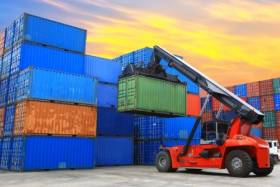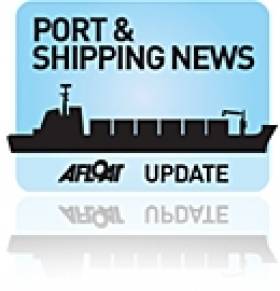Displaying items by tag: LoLo
New Ships, New LoLo Services Between Dublin, Cork and Rotterdam
CLdN, headquartered in Luxembourg, has chartered two 962 TEU lift-on / lift-off (LoLo) cargo vessels, M/V Pavo J and M/V Andromeda J) to sail new services between its recently acquired Distriport terminal in Rotterdam, Dublin and Cork.
It says this is being done in response to high-level customer demand for freight movement between Ireland and the European mainland.
“The introduction of the new LoLo services will also enable an optimisation of CLdN’s roll-on / roll-off (RoRo) fleet deployment, thereby increasing capacity on the routes between Rotterdam and the UK,” the company said in the announcement.
“The two additional weekly LoLo sailings complement the three RoRo sailings operated by CLdN each week to and from Dublin. These RoRo services will continue to operate from CLdN’s RoRo terminal in Rotterdam. The LoLo service to Cork complements the RoRo service operated by CLdN from its Zeebrugge terminal.
The new services will start on March 18. Last December, 3.5 hectares of terminal area were added to Dublin. It says it operates 500,000 cargo units a year to and from Ireland, “the largest mover of ferry freight between Ireland and mainland Europe / Great Britain.
Its services operational weekly schedule will now be: Rotterdam ⟷ Dublin : 5 sailings; Rotterdam ⟷ Cork : 1 sailing;Zeebrugge ⟷ Dublin : 2 sailings; Zeebrugge ⟷ Cork : 2 sailings;Santander ⟷ Dublin : 2 sailings; Liverpool ⟷ Dublin : 60 sailings;Heysham ⟷ Dublin : 6 sailings
Container Volumes at Irish Ports Fell Sharply in First Half of 2023 — But Encouraging Signs as Inflation Eases, IMDO Says
Volumes handled by the Roll-on/Roll-off (RoRo) and Lift-on/Lift-off (LoLo) cargo modes at Irish ports declined significantly in the first six months of 2023, according to a new report from the Irish Maritime Development Office (IMDO).
When compared to the first half of 2022, RoRo volumes fell by 3%, equivalent to 20,000 fewer RoRo units. LoLo traffic fell by 9%, or 55,000 TEU’s, over the same period.
The IMDO says the predominant driver of these declines has been inflation, which has risen considerably both at home and abroad over the last 18 months.
Beginning with a rapid rise in energy costs in early 2022, the cost of transporting goods, and the cost of goods themselves, has risen sharply. This has suppressed trade at Irish ports, with traffic on almost all routes declining to some degree.
In the RoRo market, volumes in Q1 and Q2 declined by 4% and 3% respectively. Volumes in both quarters were below the long -term trend for the sector, the benchmark for which is approximately 300,000 units per quarter. When seasonally adjusted, RoRo traffic declined on a quarterly basis in four of the last five quarters.
Rosslare-Europort was the only port to record an increase compared to 2022. This was driven by an announcement in late 2022 that a Cork-Zeebrugge service operated by Grimaldi would move to Rosslare Europort. Finnlines, a Finnish shipping company that is part of the Grimaldi Group, now operates the service from Rosslare.
The breakdown in RoRo traffic between ports in mainland Great Britain (ROI–GB) and ports in mainland Europe (ROI–EU) has now exhibited the same post-Brexit trends for ten consecutive quarters. ROI–EU, or direct, RoRo traffic continues to represent one in three RoRo units, compared to one in three prior to January 2021. As a result, there is no immediate sign of a return to the pre-Brexit makeup of the Irish RoRo freight market.
In the LoLo market, volumes in Q1 and Q2 declined by 7% and 11% respectively. The declines in LoLo traffic were also reflected at an international level. Global seaborne trade indicators for container traffic exhibited sharp declines, particularly in the early months of 2023, a trend that was mirrored at Irish ports.
Overall, the volumes recorded in the unitised freight market at Irish ports in the first half of 2023 were sluggish, below trend, and reflective of the suppressive effect inflation has had on international trade volumes.
However, there are several reasons to be optimistic about the near future for Irish maritime traffic, the IMDO adds.
Firstly, inflation has begun to ease across the EU. In Ireland, the inflation rate in July was 4.6%, its lowest level since September 2021. Secondly, according to latest Central Bank reports, domestic growth in Ireland remains robust and is higher than what was expected earlier in the year. Unemployment is extremely low, and this is creating resilience within the economy.
Abroad, EU growth is subdued, while US growth is improving. Both are also buoyed by high employment levels. Most importantly, global inflation rates are easing.
In all, there are positive signals that the declines recorded at Irish ports may be temporary, and that the worst period may have passed, the IMDO says, as it emphasises that “there is a resilience in the Irish maritime freight market”—demonstrated by the response to disruption from both Brexit and the pandemic—“that is essential to overcoming economic headwinds such as these”.
The Unitised Traffic Report Q1 & Q2 2023 is attached below.
The Port of Waterford has recently announced its trading activity for 2021 and the 1st half of 2022.
Financial Results 2021
The financial statements for 2021 have recently been laid before the Oireachtas and are now available on the Company website, The Company is reporting operating profits for the financial year of €1.1 million, up from the €0.7 million recorded in 2020. Turnover was €7.7m (2020: €7.2m) and shareholder’s funds ended the year at €34m.
Bulk throughput in 2021 came in at 1.7 million tonnes, an 11% increase on 2020, while containers handled remained broadly in line with 2020.
Activity 1st Half 2022
The business is again showing positive momentum in 2022 with bulk handling ahead of 2021 by over 12% at the half year and laden container throughput up 5% on last year.
Comment
Frank Ronan, Chief Executive, said: ‘The Port performed well in 2021 despite the many challenges we all faced in that year. We have seen further recovery in the 1st half of 2022 in our parking income, continued growth in bulk and container volumes and an overall step up in developmental activity. However, as in other areas of the economy, we too are experiencing significant cost pressures and volatility in some throughputs as we move into the second half of the year. The Company is very well placed to handle a significant level of onshore renewable wind projects in the coming years and well positioned to support the offshore industry as it gears up for major investment later this decade’.
Cruise Tourism
Frank Ronan concluded by welcoming the return of cruise ships visiting Waterford Harbour during this summer. He noted: ‘We are delighted to be working with the local Cruise Co-operative and Dunmore East Fishery Harbour again to deliver business for our region’s tourism and hospitality operators. The return of these visitors is particularly welcome following on from what has been a really difficult time for this sector’.
Irish Shipping Volumes Rise By 1% In Q2 2017
#Shipping - Shipping and port activity in the Republic of Ireland rose by 1% in the second quarter of 2017 when compared to the corresponding period of 2016, according to the latest iShip Index published by the Irish Maritime Development Office (IMDO).
Unitised traffic — which consists of roll-on/roll-off (RORO) and lift-on/lift-off (LOLO) traffic — continued to rise, growing by 3% when compared to Q2 2016.
The majority of RORO traffic moves between Ireland and Great Britain, meaning this freight segment is a simple but reliable indicator as to the level of trade between both economies.
The RORO freight sector for the Republic of Ireland saw volume growth of 3% in the second quarter of 2017. This is the fifth consecutive Q2 increase in this freight category.
As for LOLO (containership) traffic, exports in the Republic of Ireland (ROI) rose by 7.4% compared to Q2 2016, while imports remained relatively unchanged — rising by 0.9%. Overall, LOLO traffic in ROI increased by 3.7% to 184,673 TEU.
When reviewing unitised traffic, it is worth noting that both LOLO and RORO freight segments move in an all-island setting. Therefore, when Northern Irish ports are included, all-island RORO volumes grew by 2% in Q2 2017.
All-island LOLO traffic grew by 3.5%, with all-island imports and exports rising by 1.1% and 6.6% respectively compared to Q2 2016.
NI RORO volumes grew by 2%, while NI LOLO traffic grew by 2.8%. This was driven primarily by 4% growth in NI LOLO exports.
The bulk traffic segment saw tonnage volumes decrease by 1% (excluding transhipments) in the Republic of Ireland when compared to the same period last year. This was driven primarily by a 3% fall in Dry Bulk tonnage.
Break bulk volumes grew by 3%, while liquid Bulk traffic remained stable compared to Q2 2016.
Summary of Shipping Volumes for Republic of Ireland:

Port & Shipping Volumes Continue Slowdown in 3rd Quarter
#PORTS & SHIPPING- The volume of shipping and port traffic through the Republic of Ireland continued to decline during the third quarter of 2011, according to the latest analysis of traffic figures released by the Irish Maritime Development Office (IMDO).
Results from third quarter data indicate that only 1 of the 5 principal freight segments had any growth over the third quarter, while all other segments declined compared to the same period last year as outlined below in the key third quarter data:-
• Lift-on/Lift-off (lo/lo) trades were down 5%
• Roll-on/Roll-off export traffic was down by 2%
• Dry bulk volumes increased by 2%
• Break bulk volumes were down by 3%
• The Tanker/Liquid bulk market was down 7%.
For a more in-depth analysis of each freight-transport mode issued by the IMDO and accompanied by graphic charts click HERE. In addition to compare the 3rd quarter figures with the previous 2nd quater for this year click HERE.

























































